Palliative Care: Exploring Grief, Bereavement, and Mourning
VerifiedAdded on 2020/03/07
|9
|2924
|76
Essay
AI Summary
This essay delves into the realm of palliative care, elucidating its significance in addressing grief and bereavement. It defines palliative care as specialized medical support for individuals facing serious illnesses, emphasizing the importance of holistic care and community development. The essay explores grief as the emotional response to loss, detailing various causes and impacts, alongside an understanding of bereavement as the process of grieving. A central focus is on Worden's Four Tasks of Mourning, outlining the critical steps involved in navigating loss: accepting the reality of the loss, processing the pain of grief, adjusting to a world without the deceased, and finding an enduring connection. The essay also outlines the stages of grief, including shock, denial, pain, bargaining, depression, upward turn, reconstruction, and acceptance, underscoring the role of health and social care professionals in providing support. The conclusion reinforces the value of Worden's model in guiding individuals through grief and bereavement, advocating for its integration into palliative care services to offer hope and support to those in need.
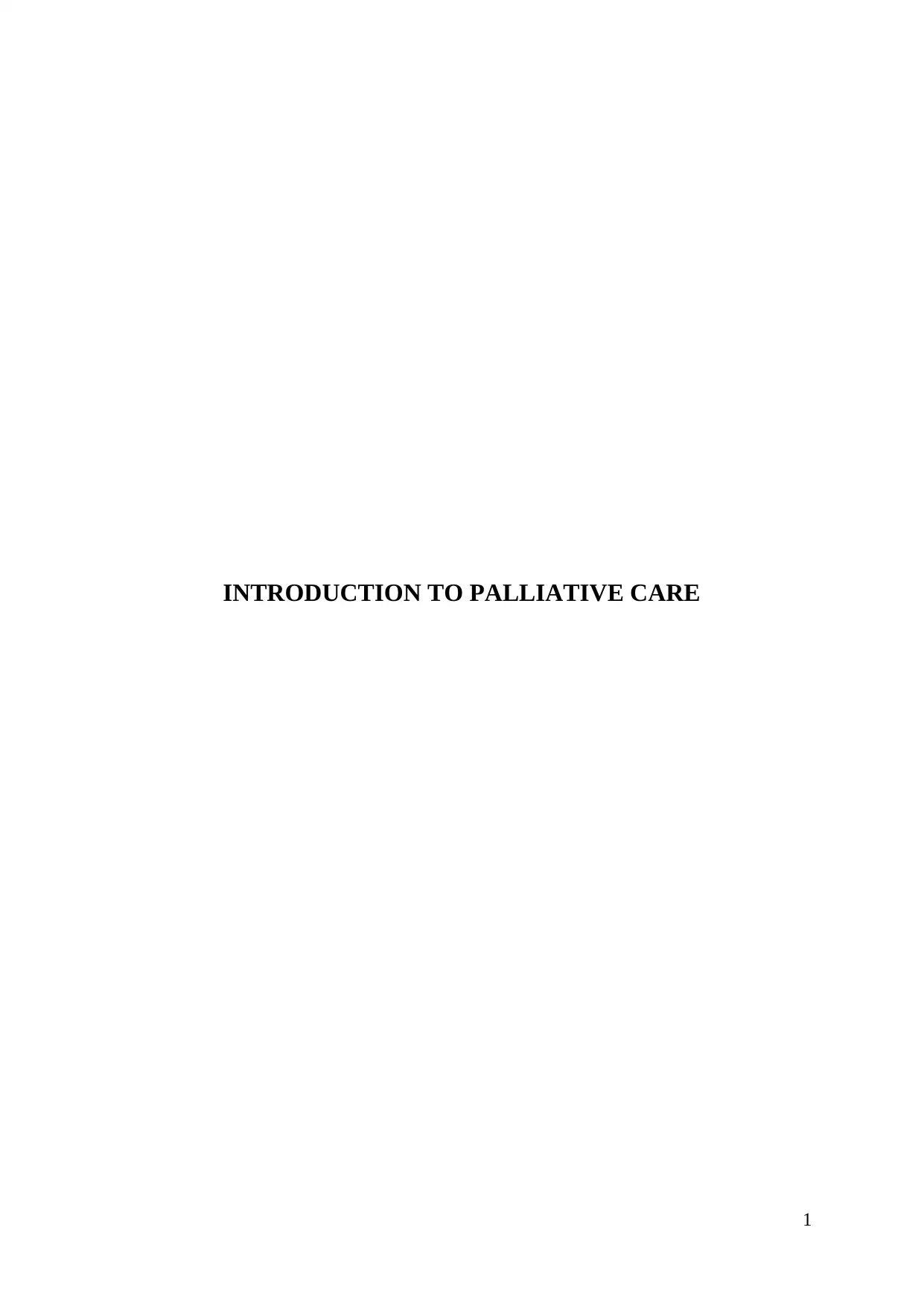
INTRODUCTION TO PALLIATIVE CARE
1
1
Paraphrase This Document
Need a fresh take? Get an instant paraphrase of this document with our AI Paraphraser
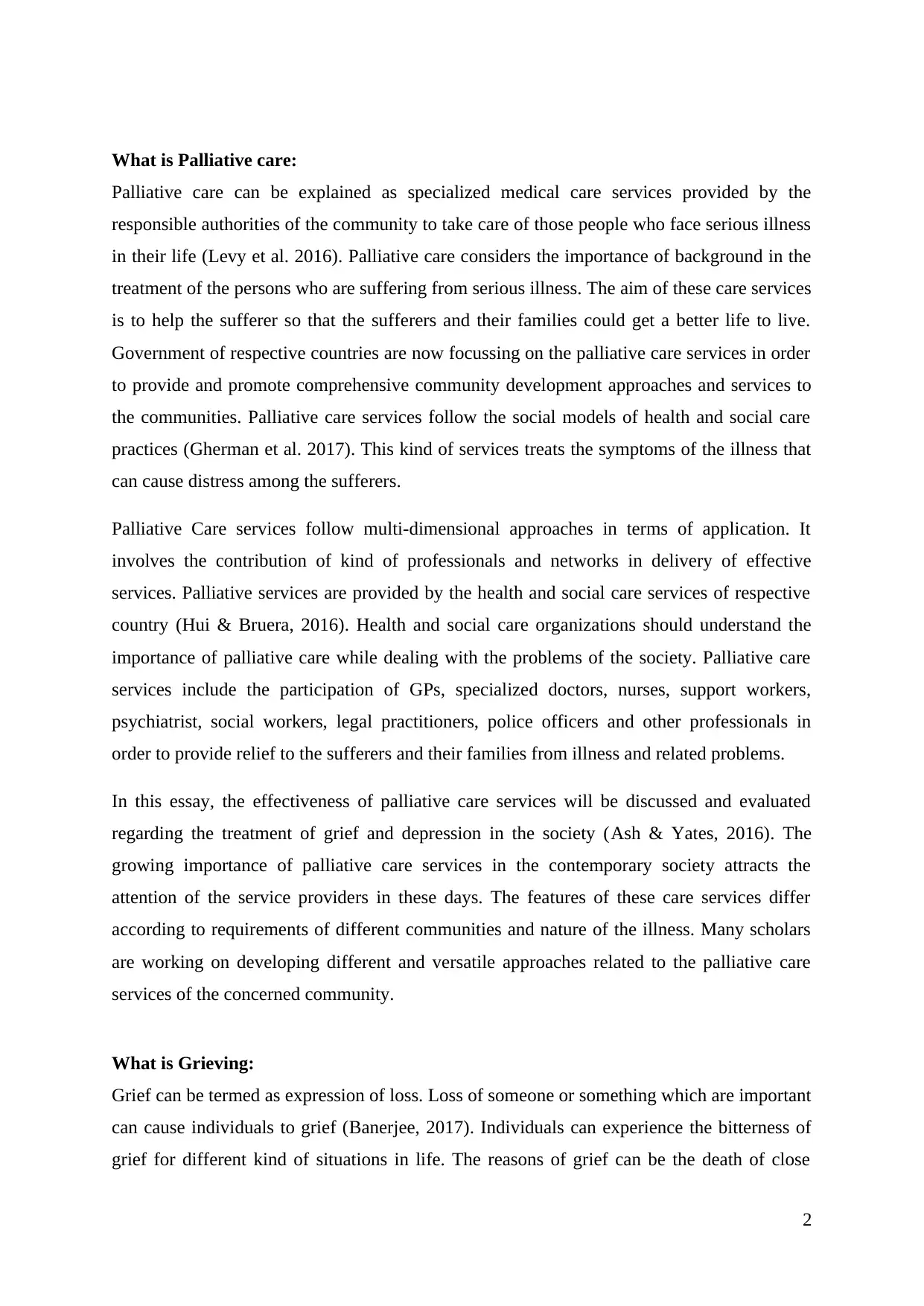
What is Palliative care:
Palliative care can be explained as specialized medical care services provided by the
responsible authorities of the community to take care of those people who face serious illness
in their life (Levy et al. 2016). Palliative care considers the importance of background in the
treatment of the persons who are suffering from serious illness. The aim of these care services
is to help the sufferer so that the sufferers and their families could get a better life to live.
Government of respective countries are now focussing on the palliative care services in order
to provide and promote comprehensive community development approaches and services to
the communities. Palliative care services follow the social models of health and social care
practices (Gherman et al. 2017). This kind of services treats the symptoms of the illness that
can cause distress among the sufferers.
Palliative Care services follow multi-dimensional approaches in terms of application. It
involves the contribution of kind of professionals and networks in delivery of effective
services. Palliative services are provided by the health and social care services of respective
country (Hui & Bruera, 2016). Health and social care organizations should understand the
importance of palliative care while dealing with the problems of the society. Palliative care
services include the participation of GPs, specialized doctors, nurses, support workers,
psychiatrist, social workers, legal practitioners, police officers and other professionals in
order to provide relief to the sufferers and their families from illness and related problems.
In this essay, the effectiveness of palliative care services will be discussed and evaluated
regarding the treatment of grief and depression in the society (Ash & Yates, 2016). The
growing importance of palliative care services in the contemporary society attracts the
attention of the service providers in these days. The features of these care services differ
according to requirements of different communities and nature of the illness. Many scholars
are working on developing different and versatile approaches related to the palliative care
services of the concerned community.
What is Grieving:
Grief can be termed as expression of loss. Loss of someone or something which are important
can cause individuals to grief (Banerjee, 2017). Individuals can experience the bitterness of
grief for different kind of situations in life. The reasons of grief can be the death of close
2
Palliative care can be explained as specialized medical care services provided by the
responsible authorities of the community to take care of those people who face serious illness
in their life (Levy et al. 2016). Palliative care considers the importance of background in the
treatment of the persons who are suffering from serious illness. The aim of these care services
is to help the sufferer so that the sufferers and their families could get a better life to live.
Government of respective countries are now focussing on the palliative care services in order
to provide and promote comprehensive community development approaches and services to
the communities. Palliative care services follow the social models of health and social care
practices (Gherman et al. 2017). This kind of services treats the symptoms of the illness that
can cause distress among the sufferers.
Palliative Care services follow multi-dimensional approaches in terms of application. It
involves the contribution of kind of professionals and networks in delivery of effective
services. Palliative services are provided by the health and social care services of respective
country (Hui & Bruera, 2016). Health and social care organizations should understand the
importance of palliative care while dealing with the problems of the society. Palliative care
services include the participation of GPs, specialized doctors, nurses, support workers,
psychiatrist, social workers, legal practitioners, police officers and other professionals in
order to provide relief to the sufferers and their families from illness and related problems.
In this essay, the effectiveness of palliative care services will be discussed and evaluated
regarding the treatment of grief and depression in the society (Ash & Yates, 2016). The
growing importance of palliative care services in the contemporary society attracts the
attention of the service providers in these days. The features of these care services differ
according to requirements of different communities and nature of the illness. Many scholars
are working on developing different and versatile approaches related to the palliative care
services of the concerned community.
What is Grieving:
Grief can be termed as expression of loss. Loss of someone or something which are important
can cause individuals to grief (Banerjee, 2017). Individuals can experience the bitterness of
grief for different kind of situations in life. The reasons of grief can be the death of close
2
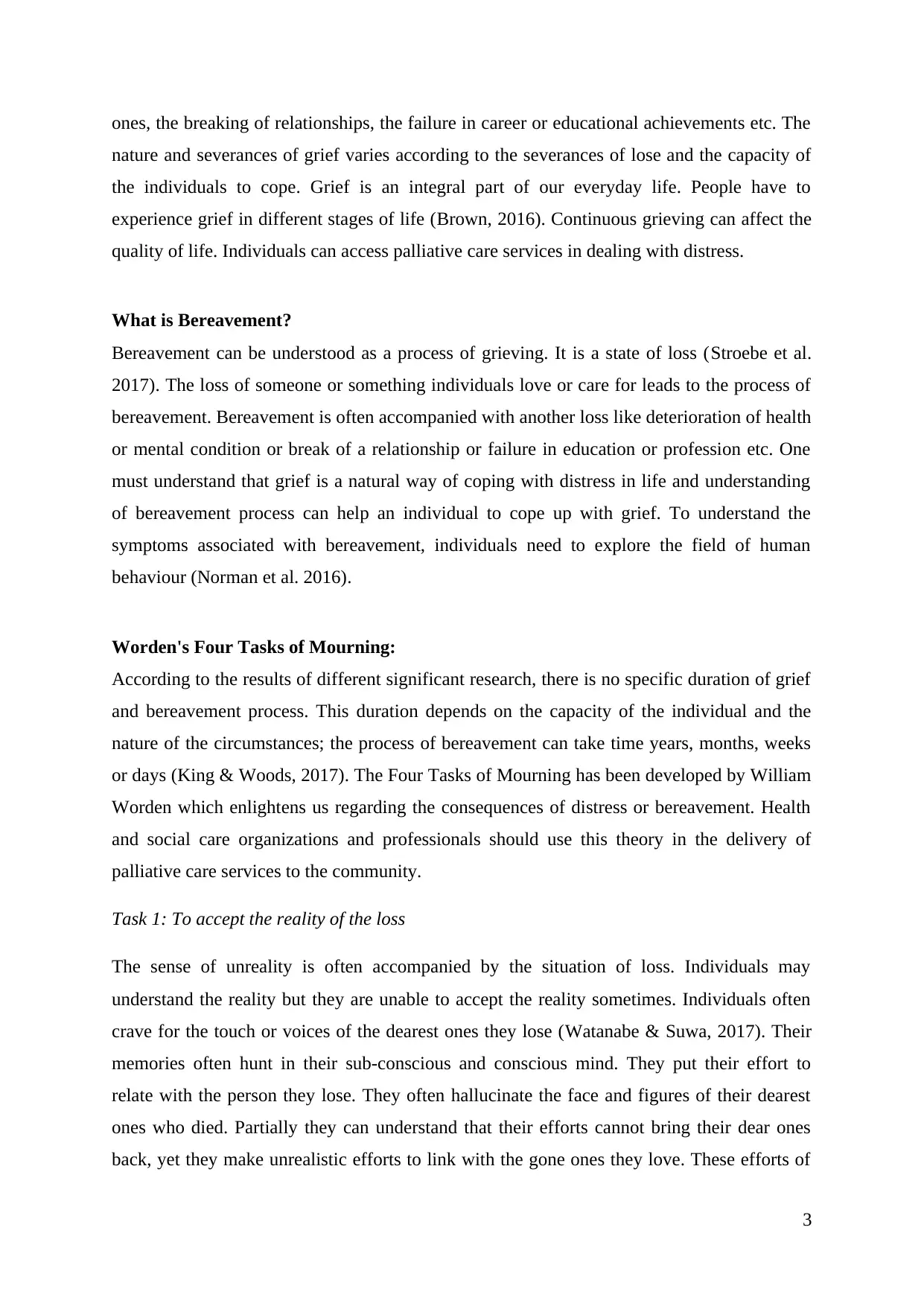
ones, the breaking of relationships, the failure in career or educational achievements etc. The
nature and severances of grief varies according to the severances of lose and the capacity of
the individuals to cope. Grief is an integral part of our everyday life. People have to
experience grief in different stages of life (Brown, 2016). Continuous grieving can affect the
quality of life. Individuals can access palliative care services in dealing with distress.
What is Bereavement?
Bereavement can be understood as a process of grieving. It is a state of loss (Stroebe et al.
2017). The loss of someone or something individuals love or care for leads to the process of
bereavement. Bereavement is often accompanied with another loss like deterioration of health
or mental condition or break of a relationship or failure in education or profession etc. One
must understand that grief is a natural way of coping with distress in life and understanding
of bereavement process can help an individual to cope up with grief. To understand the
symptoms associated with bereavement, individuals need to explore the field of human
behaviour (Norman et al. 2016).
Worden's Four Tasks of Mourning:
According to the results of different significant research, there is no specific duration of grief
and bereavement process. This duration depends on the capacity of the individual and the
nature of the circumstances; the process of bereavement can take time years, months, weeks
or days (King & Woods, 2017). The Four Tasks of Mourning has been developed by William
Worden which enlightens us regarding the consequences of distress or bereavement. Health
and social care organizations and professionals should use this theory in the delivery of
palliative care services to the community.
Task 1: To accept the reality of the loss
The sense of unreality is often accompanied by the situation of loss. Individuals may
understand the reality but they are unable to accept the reality sometimes. Individuals often
crave for the touch or voices of the dearest ones they lose (Watanabe & Suwa, 2017). Their
memories often hunt in their sub-conscious and conscious mind. They put their effort to
relate with the person they lose. They often hallucinate the face and figures of their dearest
ones who died. Partially they can understand that their efforts cannot bring their dear ones
back, yet they make unrealistic efforts to link with the gone ones they love. These efforts of
3
nature and severances of grief varies according to the severances of lose and the capacity of
the individuals to cope. Grief is an integral part of our everyday life. People have to
experience grief in different stages of life (Brown, 2016). Continuous grieving can affect the
quality of life. Individuals can access palliative care services in dealing with distress.
What is Bereavement?
Bereavement can be understood as a process of grieving. It is a state of loss (Stroebe et al.
2017). The loss of someone or something individuals love or care for leads to the process of
bereavement. Bereavement is often accompanied with another loss like deterioration of health
or mental condition or break of a relationship or failure in education or profession etc. One
must understand that grief is a natural way of coping with distress in life and understanding
of bereavement process can help an individual to cope up with grief. To understand the
symptoms associated with bereavement, individuals need to explore the field of human
behaviour (Norman et al. 2016).
Worden's Four Tasks of Mourning:
According to the results of different significant research, there is no specific duration of grief
and bereavement process. This duration depends on the capacity of the individual and the
nature of the circumstances; the process of bereavement can take time years, months, weeks
or days (King & Woods, 2017). The Four Tasks of Mourning has been developed by William
Worden which enlightens us regarding the consequences of distress or bereavement. Health
and social care organizations and professionals should use this theory in the delivery of
palliative care services to the community.
Task 1: To accept the reality of the loss
The sense of unreality is often accompanied by the situation of loss. Individuals may
understand the reality but they are unable to accept the reality sometimes. Individuals often
crave for the touch or voices of the dearest ones they lose (Watanabe & Suwa, 2017). Their
memories often hunt in their sub-conscious and conscious mind. They put their effort to
relate with the person they lose. They often hallucinate the face and figures of their dearest
ones who died. Partially they can understand that their efforts cannot bring their dear ones
back, yet they make unrealistic efforts to link with the gone ones they love. These efforts of
3
⊘ This is a preview!⊘
Do you want full access?
Subscribe today to unlock all pages.

Trusted by 1+ million students worldwide
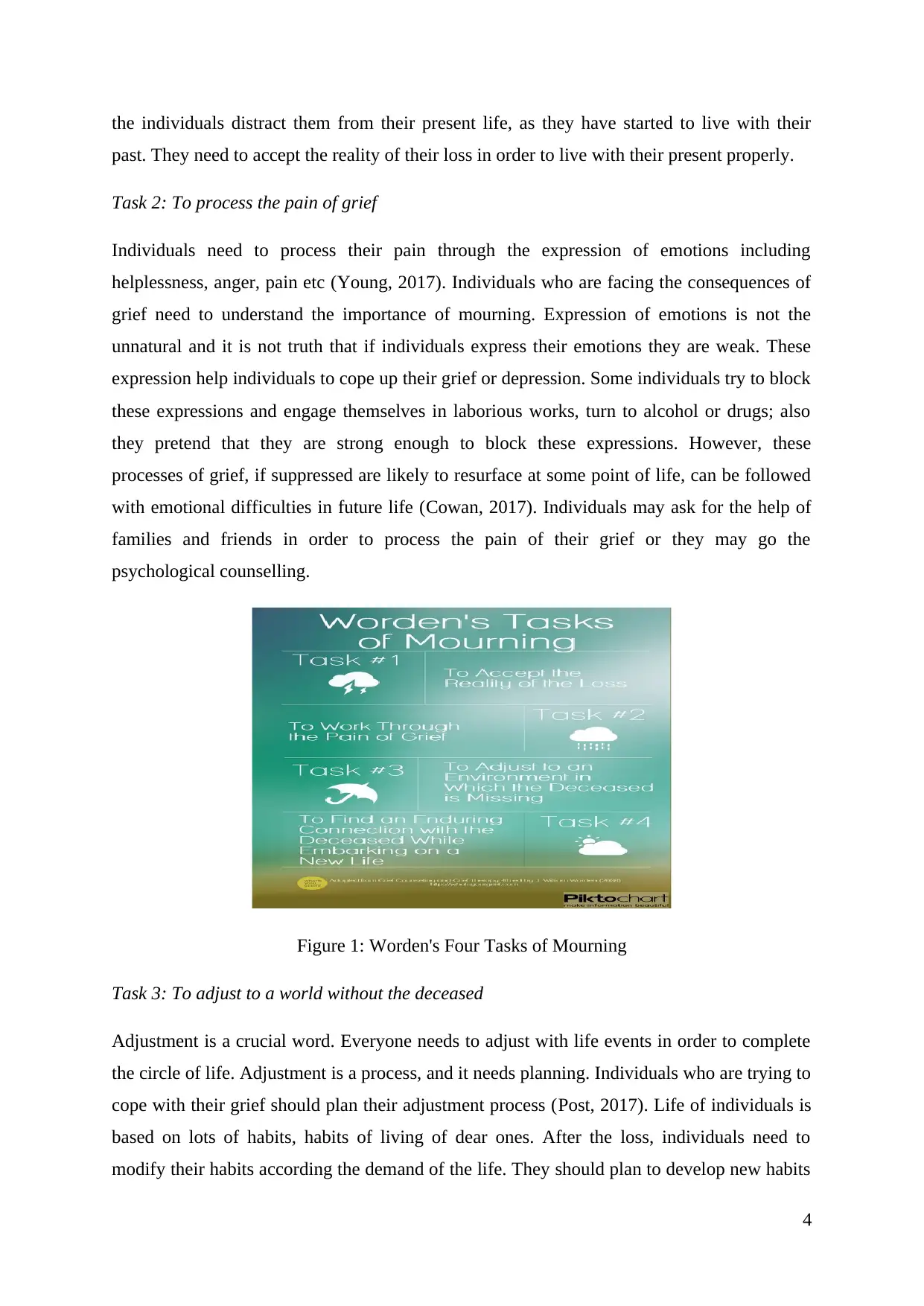
the individuals distract them from their present life, as they have started to live with their
past. They need to accept the reality of their loss in order to live with their present properly.
Task 2: To process the pain of grief
Individuals need to process their pain through the expression of emotions including
helplessness, anger, pain etc (Young, 2017). Individuals who are facing the consequences of
grief need to understand the importance of mourning. Expression of emotions is not the
unnatural and it is not truth that if individuals express their emotions they are weak. These
expression help individuals to cope up their grief or depression. Some individuals try to block
these expressions and engage themselves in laborious works, turn to alcohol or drugs; also
they pretend that they are strong enough to block these expressions. However, these
processes of grief, if suppressed are likely to resurface at some point of life, can be followed
with emotional difficulties in future life (Cowan, 2017). Individuals may ask for the help of
families and friends in order to process the pain of their grief or they may go the
psychological counselling.
Figure 1: Worden's Four Tasks of Mourning
Task 3: To adjust to a world without the deceased
Adjustment is a crucial word. Everyone needs to adjust with life events in order to complete
the circle of life. Adjustment is a process, and it needs planning. Individuals who are trying to
cope with their grief should plan their adjustment process (Post, 2017). Life of individuals is
based on lots of habits, habits of living of dear ones. After the loss, individuals need to
modify their habits according the demand of the life. They should plan to develop new habits
4
past. They need to accept the reality of their loss in order to live with their present properly.
Task 2: To process the pain of grief
Individuals need to process their pain through the expression of emotions including
helplessness, anger, pain etc (Young, 2017). Individuals who are facing the consequences of
grief need to understand the importance of mourning. Expression of emotions is not the
unnatural and it is not truth that if individuals express their emotions they are weak. These
expression help individuals to cope up their grief or depression. Some individuals try to block
these expressions and engage themselves in laborious works, turn to alcohol or drugs; also
they pretend that they are strong enough to block these expressions. However, these
processes of grief, if suppressed are likely to resurface at some point of life, can be followed
with emotional difficulties in future life (Cowan, 2017). Individuals may ask for the help of
families and friends in order to process the pain of their grief or they may go the
psychological counselling.
Figure 1: Worden's Four Tasks of Mourning
Task 3: To adjust to a world without the deceased
Adjustment is a crucial word. Everyone needs to adjust with life events in order to complete
the circle of life. Adjustment is a process, and it needs planning. Individuals who are trying to
cope with their grief should plan their adjustment process (Post, 2017). Life of individuals is
based on lots of habits, habits of living of dear ones. After the loss, individuals need to
modify their habits according the demand of the life. They should plan to develop new habits
4
Paraphrase This Document
Need a fresh take? Get an instant paraphrase of this document with our AI Paraphraser
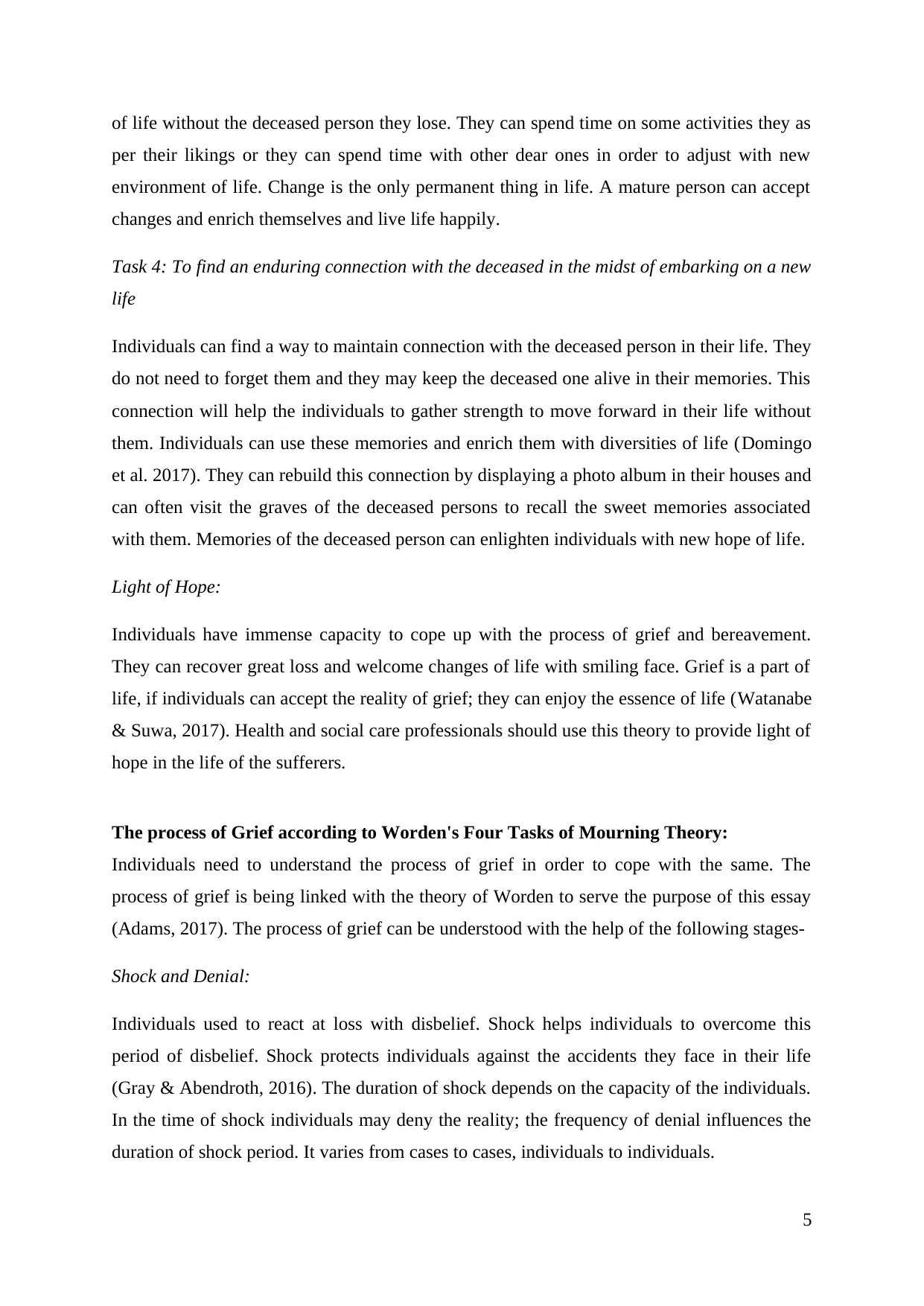
of life without the deceased person they lose. They can spend time on some activities they as
per their likings or they can spend time with other dear ones in order to adjust with new
environment of life. Change is the only permanent thing in life. A mature person can accept
changes and enrich themselves and live life happily.
Task 4: To find an enduring connection with the deceased in the midst of embarking on a new
life
Individuals can find a way to maintain connection with the deceased person in their life. They
do not need to forget them and they may keep the deceased one alive in their memories. This
connection will help the individuals to gather strength to move forward in their life without
them. Individuals can use these memories and enrich them with diversities of life (Domingo
et al. 2017). They can rebuild this connection by displaying a photo album in their houses and
can often visit the graves of the deceased persons to recall the sweet memories associated
with them. Memories of the deceased person can enlighten individuals with new hope of life.
Light of Hope:
Individuals have immense capacity to cope up with the process of grief and bereavement.
They can recover great loss and welcome changes of life with smiling face. Grief is a part of
life, if individuals can accept the reality of grief; they can enjoy the essence of life (Watanabe
& Suwa, 2017). Health and social care professionals should use this theory to provide light of
hope in the life of the sufferers.
The process of Grief according to Worden's Four Tasks of Mourning Theory:
Individuals need to understand the process of grief in order to cope with the same. The
process of grief is being linked with the theory of Worden to serve the purpose of this essay
(Adams, 2017). The process of grief can be understood with the help of the following stages-
Shock and Denial:
Individuals used to react at loss with disbelief. Shock helps individuals to overcome this
period of disbelief. Shock protects individuals against the accidents they face in their life
(Gray & Abendroth, 2016). The duration of shock depends on the capacity of the individuals.
In the time of shock individuals may deny the reality; the frequency of denial influences the
duration of shock period. It varies from cases to cases, individuals to individuals.
5
per their likings or they can spend time with other dear ones in order to adjust with new
environment of life. Change is the only permanent thing in life. A mature person can accept
changes and enrich themselves and live life happily.
Task 4: To find an enduring connection with the deceased in the midst of embarking on a new
life
Individuals can find a way to maintain connection with the deceased person in their life. They
do not need to forget them and they may keep the deceased one alive in their memories. This
connection will help the individuals to gather strength to move forward in their life without
them. Individuals can use these memories and enrich them with diversities of life (Domingo
et al. 2017). They can rebuild this connection by displaying a photo album in their houses and
can often visit the graves of the deceased persons to recall the sweet memories associated
with them. Memories of the deceased person can enlighten individuals with new hope of life.
Light of Hope:
Individuals have immense capacity to cope up with the process of grief and bereavement.
They can recover great loss and welcome changes of life with smiling face. Grief is a part of
life, if individuals can accept the reality of grief; they can enjoy the essence of life (Watanabe
& Suwa, 2017). Health and social care professionals should use this theory to provide light of
hope in the life of the sufferers.
The process of Grief according to Worden's Four Tasks of Mourning Theory:
Individuals need to understand the process of grief in order to cope with the same. The
process of grief is being linked with the theory of Worden to serve the purpose of this essay
(Adams, 2017). The process of grief can be understood with the help of the following stages-
Shock and Denial:
Individuals used to react at loss with disbelief. Shock helps individuals to overcome this
period of disbelief. Shock protects individuals against the accidents they face in their life
(Gray & Abendroth, 2016). The duration of shock depends on the capacity of the individuals.
In the time of shock individuals may deny the reality; the frequency of denial influences the
duration of shock period. It varies from cases to cases, individuals to individuals.
5
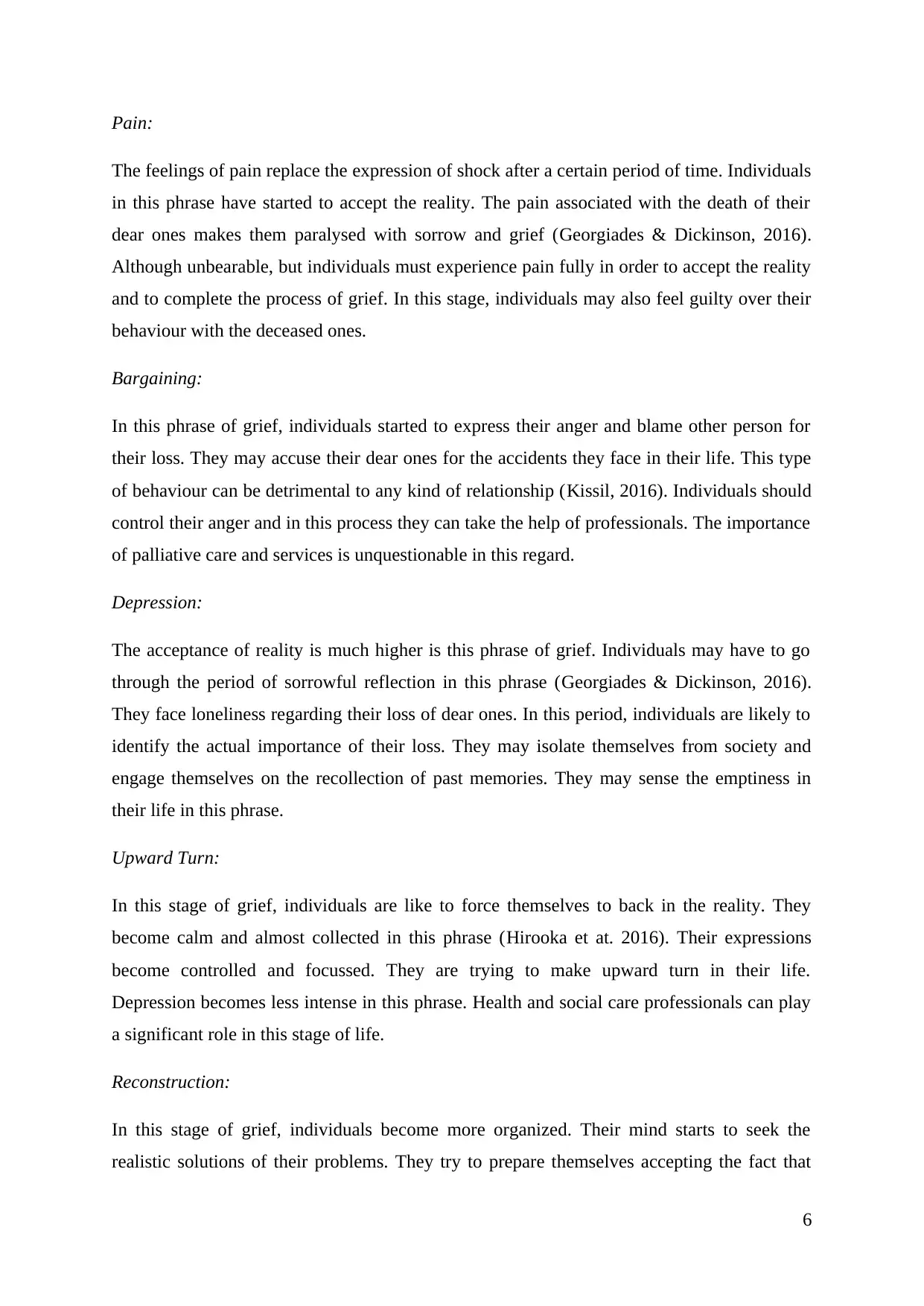
Pain:
The feelings of pain replace the expression of shock after a certain period of time. Individuals
in this phrase have started to accept the reality. The pain associated with the death of their
dear ones makes them paralysed with sorrow and grief (Georgiades & Dickinson, 2016).
Although unbearable, but individuals must experience pain fully in order to accept the reality
and to complete the process of grief. In this stage, individuals may also feel guilty over their
behaviour with the deceased ones.
Bargaining:
In this phrase of grief, individuals started to express their anger and blame other person for
their loss. They may accuse their dear ones for the accidents they face in their life. This type
of behaviour can be detrimental to any kind of relationship (Kissil, 2016). Individuals should
control their anger and in this process they can take the help of professionals. The importance
of palliative care and services is unquestionable in this regard.
Depression:
The acceptance of reality is much higher is this phrase of grief. Individuals may have to go
through the period of sorrowful reflection in this phrase (Georgiades & Dickinson, 2016).
They face loneliness regarding their loss of dear ones. In this period, individuals are likely to
identify the actual importance of their loss. They may isolate themselves from society and
engage themselves on the recollection of past memories. They may sense the emptiness in
their life in this phrase.
Upward Turn:
In this stage of grief, individuals are like to force themselves to back in the reality. They
become calm and almost collected in this phrase (Hirooka et at. 2016). Their expressions
become controlled and focussed. They are trying to make upward turn in their life.
Depression becomes less intense in this phrase. Health and social care professionals can play
a significant role in this stage of life.
Reconstruction:
In this stage of grief, individuals become more organized. Their mind starts to seek the
realistic solutions of their problems. They try to prepare themselves accepting the fact that
6
The feelings of pain replace the expression of shock after a certain period of time. Individuals
in this phrase have started to accept the reality. The pain associated with the death of their
dear ones makes them paralysed with sorrow and grief (Georgiades & Dickinson, 2016).
Although unbearable, but individuals must experience pain fully in order to accept the reality
and to complete the process of grief. In this stage, individuals may also feel guilty over their
behaviour with the deceased ones.
Bargaining:
In this phrase of grief, individuals started to express their anger and blame other person for
their loss. They may accuse their dear ones for the accidents they face in their life. This type
of behaviour can be detrimental to any kind of relationship (Kissil, 2016). Individuals should
control their anger and in this process they can take the help of professionals. The importance
of palliative care and services is unquestionable in this regard.
Depression:
The acceptance of reality is much higher is this phrase of grief. Individuals may have to go
through the period of sorrowful reflection in this phrase (Georgiades & Dickinson, 2016).
They face loneliness regarding their loss of dear ones. In this period, individuals are likely to
identify the actual importance of their loss. They may isolate themselves from society and
engage themselves on the recollection of past memories. They may sense the emptiness in
their life in this phrase.
Upward Turn:
In this stage of grief, individuals are like to force themselves to back in the reality. They
become calm and almost collected in this phrase (Hirooka et at. 2016). Their expressions
become controlled and focussed. They are trying to make upward turn in their life.
Depression becomes less intense in this phrase. Health and social care professionals can play
a significant role in this stage of life.
Reconstruction:
In this stage of grief, individuals become more organized. Their mind starts to seek the
realistic solutions of their problems. They try to prepare themselves accepting the fact that
6
⊘ This is a preview!⊘
Do you want full access?
Subscribe today to unlock all pages.

Trusted by 1+ million students worldwide
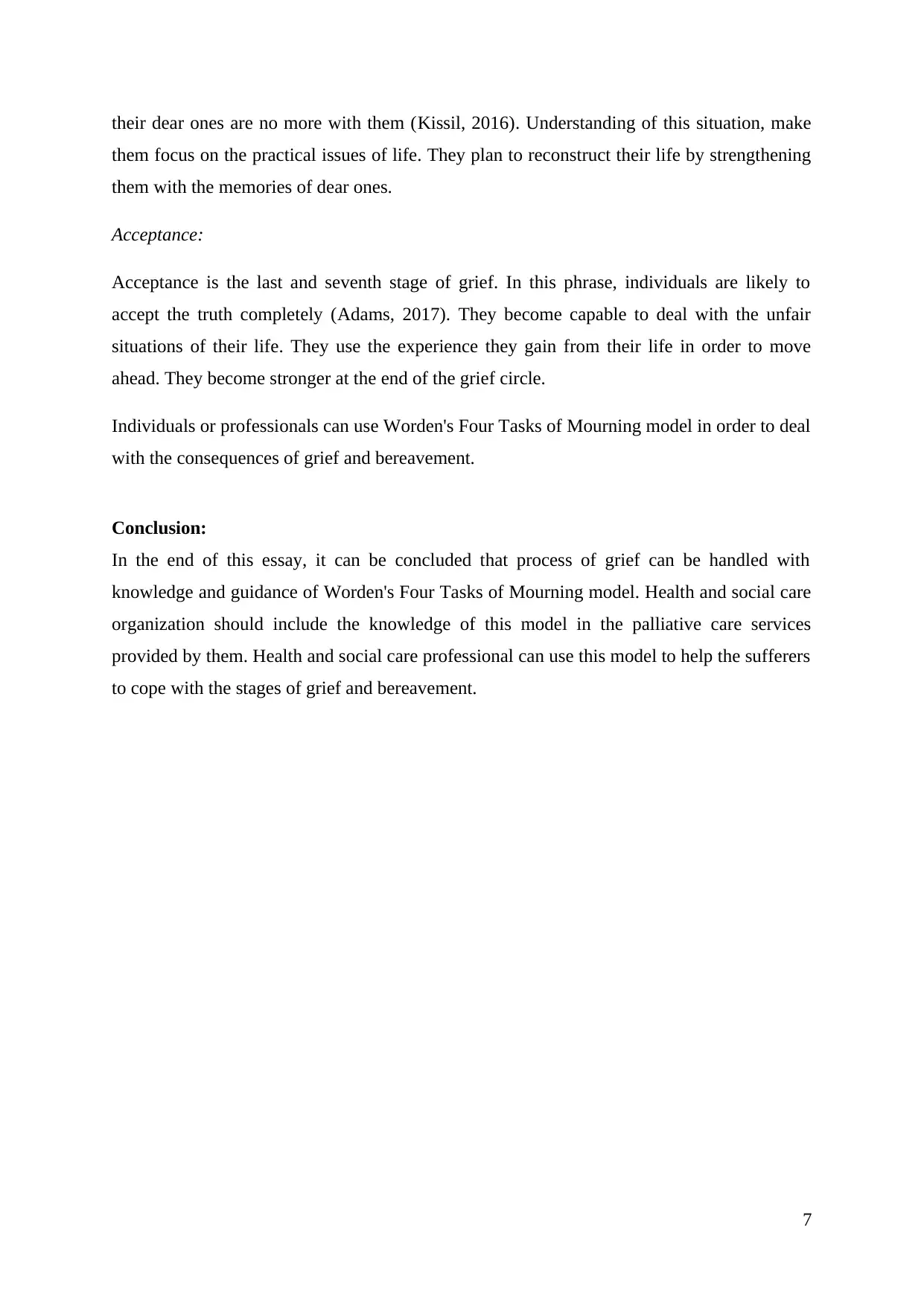
their dear ones are no more with them (Kissil, 2016). Understanding of this situation, make
them focus on the practical issues of life. They plan to reconstruct their life by strengthening
them with the memories of dear ones.
Acceptance:
Acceptance is the last and seventh stage of grief. In this phrase, individuals are likely to
accept the truth completely (Adams, 2017). They become capable to deal with the unfair
situations of their life. They use the experience they gain from their life in order to move
ahead. They become stronger at the end of the grief circle.
Individuals or professionals can use Worden's Four Tasks of Mourning model in order to deal
with the consequences of grief and bereavement.
Conclusion:
In the end of this essay, it can be concluded that process of grief can be handled with
knowledge and guidance of Worden's Four Tasks of Mourning model. Health and social care
organization should include the knowledge of this model in the palliative care services
provided by them. Health and social care professional can use this model to help the sufferers
to cope with the stages of grief and bereavement.
7
them focus on the practical issues of life. They plan to reconstruct their life by strengthening
them with the memories of dear ones.
Acceptance:
Acceptance is the last and seventh stage of grief. In this phrase, individuals are likely to
accept the truth completely (Adams, 2017). They become capable to deal with the unfair
situations of their life. They use the experience they gain from their life in order to move
ahead. They become stronger at the end of the grief circle.
Individuals or professionals can use Worden's Four Tasks of Mourning model in order to deal
with the consequences of grief and bereavement.
Conclusion:
In the end of this essay, it can be concluded that process of grief can be handled with
knowledge and guidance of Worden's Four Tasks of Mourning model. Health and social care
organization should include the knowledge of this model in the palliative care services
provided by them. Health and social care professional can use this model to help the sufferers
to cope with the stages of grief and bereavement.
7
Paraphrase This Document
Need a fresh take? Get an instant paraphrase of this document with our AI Paraphraser
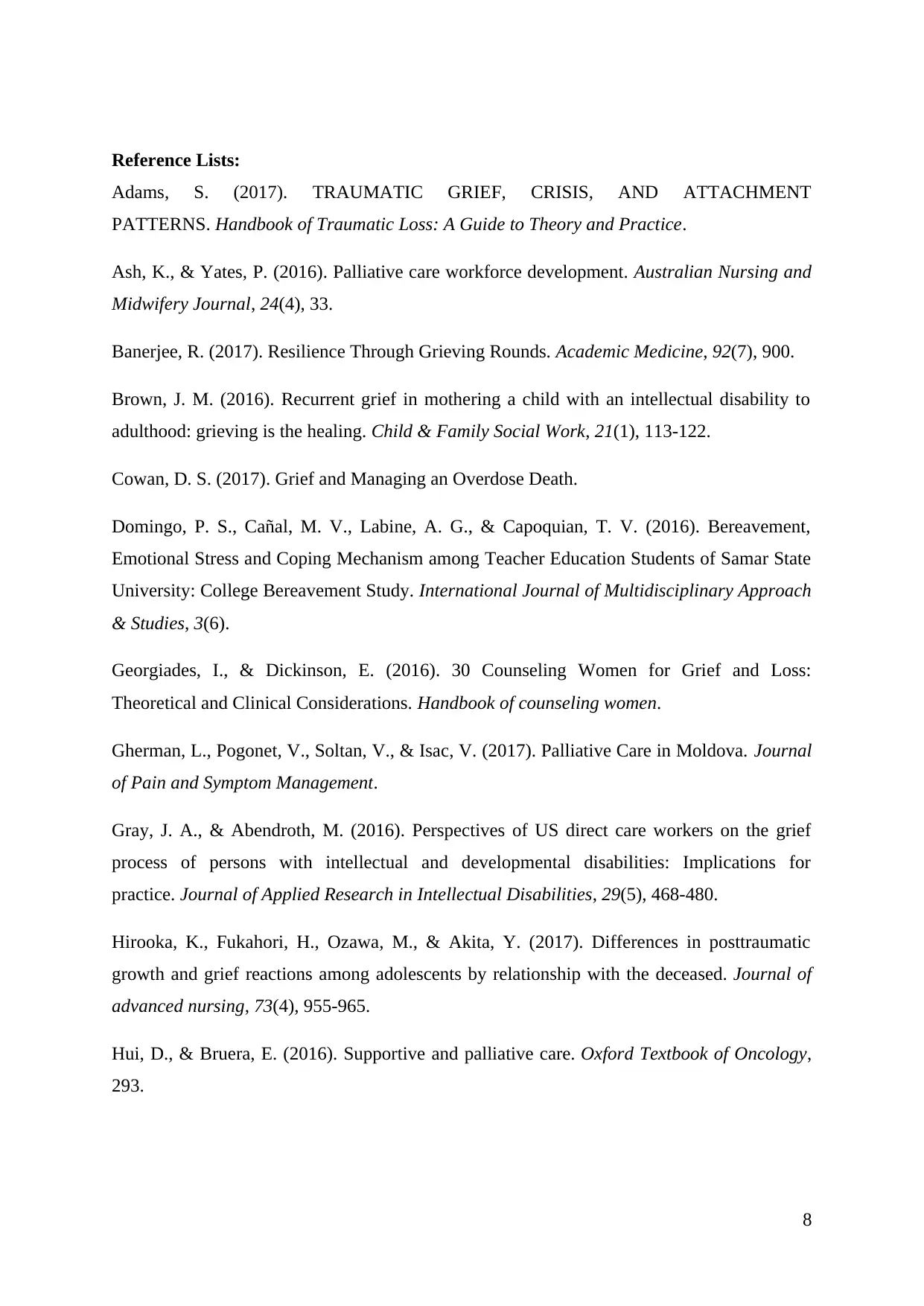
Reference Lists:
Adams, S. (2017). TRAUMATIC GRIEF, CRISIS, AND ATTACHMENT
PATTERNS. Handbook of Traumatic Loss: A Guide to Theory and Practice.
Ash, K., & Yates, P. (2016). Palliative care workforce development. Australian Nursing and
Midwifery Journal, 24(4), 33.
Banerjee, R. (2017). Resilience Through Grieving Rounds. Academic Medicine, 92(7), 900.
Brown, J. M. (2016). Recurrent grief in mothering a child with an intellectual disability to
adulthood: grieving is the healing. Child & Family Social Work, 21(1), 113-122.
Cowan, D. S. (2017). Grief and Managing an Overdose Death.
Domingo, P. S., Cañal, M. V., Labine, A. G., & Capoquian, T. V. (2016). Bereavement,
Emotional Stress and Coping Mechanism among Teacher Education Students of Samar State
University: College Bereavement Study. International Journal of Multidisciplinary Approach
& Studies, 3(6).
Georgiades, I., & Dickinson, E. (2016). 30 Counseling Women for Grief and Loss:
Theoretical and Clinical Considerations. Handbook of counseling women.
Gherman, L., Pogonet, V., Soltan, V., & Isac, V. (2017). Palliative Care in Moldova. Journal
of Pain and Symptom Management.
Gray, J. A., & Abendroth, M. (2016). Perspectives of US direct care workers on the grief
process of persons with intellectual and developmental disabilities: Implications for
practice. Journal of Applied Research in Intellectual Disabilities, 29(5), 468-480.
Hirooka, K., Fukahori, H., Ozawa, M., & Akita, Y. (2017). Differences in posttraumatic
growth and grief reactions among adolescents by relationship with the deceased. Journal of
advanced nursing, 73(4), 955-965.
Hui, D., & Bruera, E. (2016). Supportive and palliative care. Oxford Textbook of Oncology,
293.
8
Adams, S. (2017). TRAUMATIC GRIEF, CRISIS, AND ATTACHMENT
PATTERNS. Handbook of Traumatic Loss: A Guide to Theory and Practice.
Ash, K., & Yates, P. (2016). Palliative care workforce development. Australian Nursing and
Midwifery Journal, 24(4), 33.
Banerjee, R. (2017). Resilience Through Grieving Rounds. Academic Medicine, 92(7), 900.
Brown, J. M. (2016). Recurrent grief in mothering a child with an intellectual disability to
adulthood: grieving is the healing. Child & Family Social Work, 21(1), 113-122.
Cowan, D. S. (2017). Grief and Managing an Overdose Death.
Domingo, P. S., Cañal, M. V., Labine, A. G., & Capoquian, T. V. (2016). Bereavement,
Emotional Stress and Coping Mechanism among Teacher Education Students of Samar State
University: College Bereavement Study. International Journal of Multidisciplinary Approach
& Studies, 3(6).
Georgiades, I., & Dickinson, E. (2016). 30 Counseling Women for Grief and Loss:
Theoretical and Clinical Considerations. Handbook of counseling women.
Gherman, L., Pogonet, V., Soltan, V., & Isac, V. (2017). Palliative Care in Moldova. Journal
of Pain and Symptom Management.
Gray, J. A., & Abendroth, M. (2016). Perspectives of US direct care workers on the grief
process of persons with intellectual and developmental disabilities: Implications for
practice. Journal of Applied Research in Intellectual Disabilities, 29(5), 468-480.
Hirooka, K., Fukahori, H., Ozawa, M., & Akita, Y. (2017). Differences in posttraumatic
growth and grief reactions among adolescents by relationship with the deceased. Journal of
advanced nursing, 73(4), 955-965.
Hui, D., & Bruera, E. (2016). Supportive and palliative care. Oxford Textbook of Oncology,
293.
8
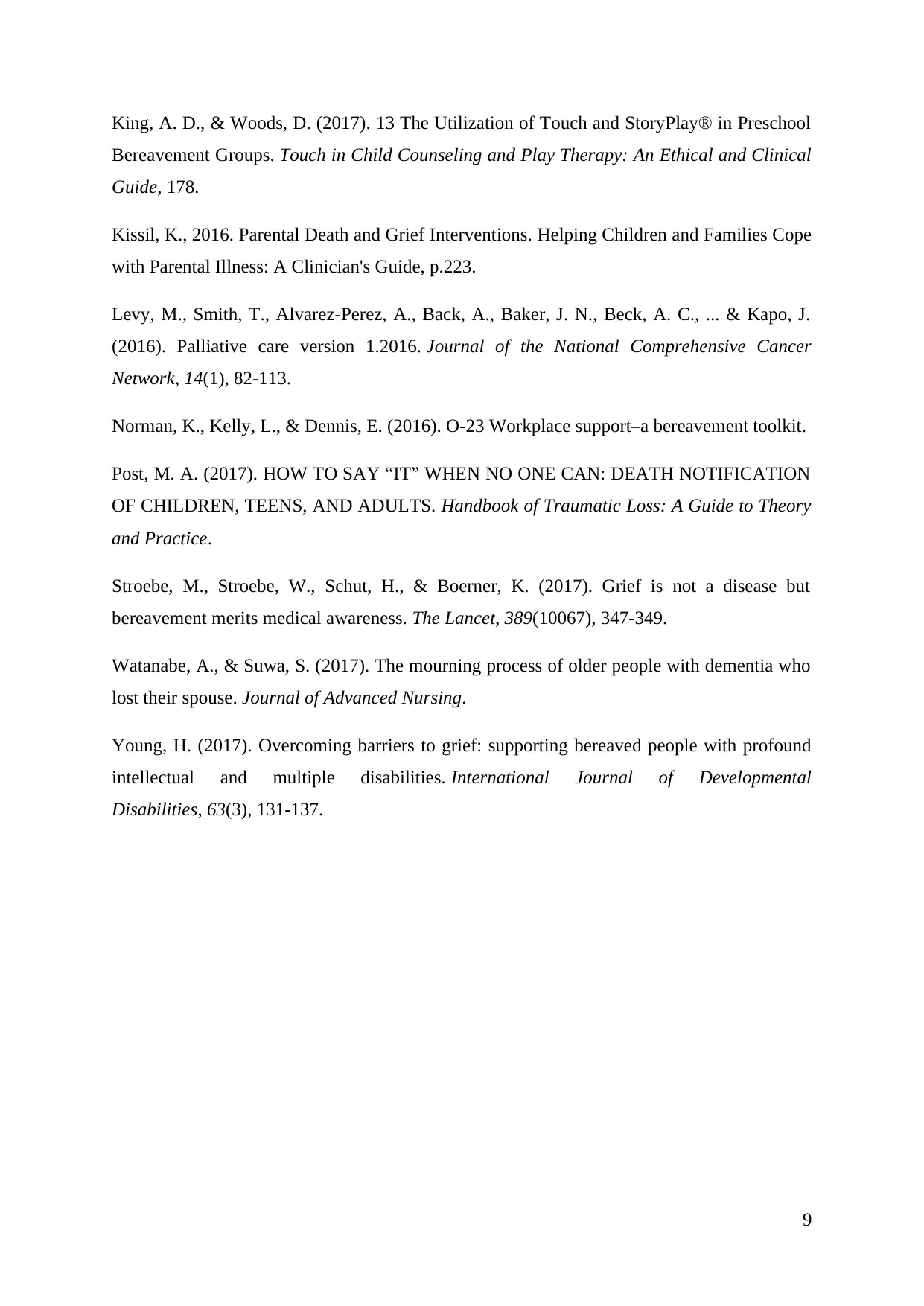
King, A. D., & Woods, D. (2017). 13 The Utilization of Touch and StoryPlay® in Preschool
Bereavement Groups. Touch in Child Counseling and Play Therapy: An Ethical and Clinical
Guide, 178.
Kissil, K., 2016. Parental Death and Grief Interventions. Helping Children and Families Cope
with Parental Illness: A Clinician's Guide, p.223.
Levy, M., Smith, T., Alvarez-Perez, A., Back, A., Baker, J. N., Beck, A. C., ... & Kapo, J.
(2016). Palliative care version 1.2016. Journal of the National Comprehensive Cancer
Network, 14(1), 82-113.
Norman, K., Kelly, L., & Dennis, E. (2016). O-23 Workplace support–a bereavement toolkit.
Post, M. A. (2017). HOW TO SAY “IT” WHEN NO ONE CAN: DEATH NOTIFICATION
OF CHILDREN, TEENS, AND ADULTS. Handbook of Traumatic Loss: A Guide to Theory
and Practice.
Stroebe, M., Stroebe, W., Schut, H., & Boerner, K. (2017). Grief is not a disease but
bereavement merits medical awareness. The Lancet, 389(10067), 347-349.
Watanabe, A., & Suwa, S. (2017). The mourning process of older people with dementia who
lost their spouse. Journal of Advanced Nursing.
Young, H. (2017). Overcoming barriers to grief: supporting bereaved people with profound
intellectual and multiple disabilities. International Journal of Developmental
Disabilities, 63(3), 131-137.
9
Bereavement Groups. Touch in Child Counseling and Play Therapy: An Ethical and Clinical
Guide, 178.
Kissil, K., 2016. Parental Death and Grief Interventions. Helping Children and Families Cope
with Parental Illness: A Clinician's Guide, p.223.
Levy, M., Smith, T., Alvarez-Perez, A., Back, A., Baker, J. N., Beck, A. C., ... & Kapo, J.
(2016). Palliative care version 1.2016. Journal of the National Comprehensive Cancer
Network, 14(1), 82-113.
Norman, K., Kelly, L., & Dennis, E. (2016). O-23 Workplace support–a bereavement toolkit.
Post, M. A. (2017). HOW TO SAY “IT” WHEN NO ONE CAN: DEATH NOTIFICATION
OF CHILDREN, TEENS, AND ADULTS. Handbook of Traumatic Loss: A Guide to Theory
and Practice.
Stroebe, M., Stroebe, W., Schut, H., & Boerner, K. (2017). Grief is not a disease but
bereavement merits medical awareness. The Lancet, 389(10067), 347-349.
Watanabe, A., & Suwa, S. (2017). The mourning process of older people with dementia who
lost their spouse. Journal of Advanced Nursing.
Young, H. (2017). Overcoming barriers to grief: supporting bereaved people with profound
intellectual and multiple disabilities. International Journal of Developmental
Disabilities, 63(3), 131-137.
9
⊘ This is a preview!⊘
Do you want full access?
Subscribe today to unlock all pages.

Trusted by 1+ million students worldwide
1 out of 9
Related Documents
Your All-in-One AI-Powered Toolkit for Academic Success.
+13062052269
info@desklib.com
Available 24*7 on WhatsApp / Email
![[object Object]](/_next/static/media/star-bottom.7253800d.svg)
Unlock your academic potential
Copyright © 2020–2025 A2Z Services. All Rights Reserved. Developed and managed by ZUCOL.





